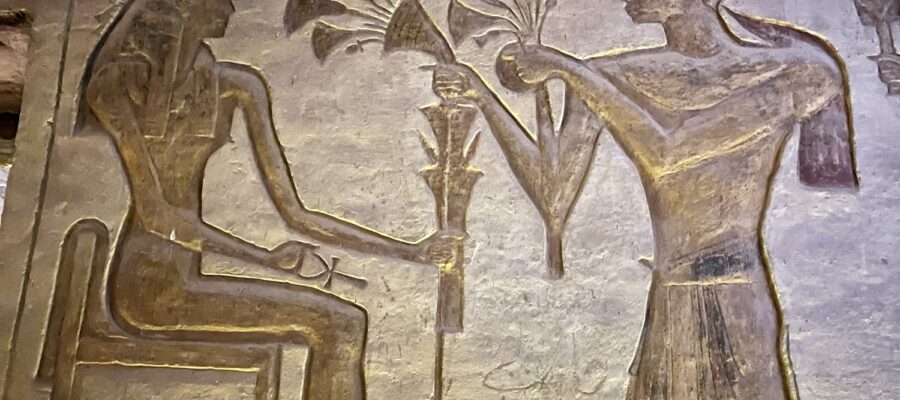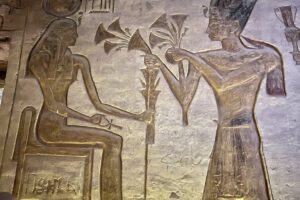






Below you will find the highlights of the first part of my trip to Egypt- a 4 day cruise along the Nile.
Day 1
- Philae Temple– The Philae Temple is known for its incredible preservation and its relocation due to the construction of the Aswan High Dam as it was originally located on the island of Philae in the Nile River. The temple complex was dedicated primarily to the goddess Isis.
- Felucca Sailing– Feluccas are particularly popular in Cairo, Luxor, and Aswan for sightseeing and scenic tours. The design of the felucca has remained relatively unchanged over time, which gives it a timeless and iconic presence in the Nile river.
Day 2
- Abu Simbel– An iconic archaeological site in southern Egypt, renowned for its two massive rock temples built by Pharaoh Ramses II. Located near the border with Sudan, it sits along the western bank of Lake Nasser. Abu Simbel’s temples are famous for their colossal statues and intricate carvings, showcasing ancient Egyptian art, religious beliefs, and Ramses II’s military prowess.
- Kom Ombo– Kom Ombo is a unique temple complex near the city of Aswan. It stands out for its unusual “double” design, dedicated to two gods: Sobek, the crocodile god associated with fertility and the Nile, and Horus the Elder, a falcon-headed god linked to the sky and protection. The temple is symmetrically divided, with two parallel halls, courts, and sanctuaries, reflecting the dual worship.
- Crocodile Museum– Located in Kom Ombo, the museum is a fascinating institution dedicated to Sobek, the crocodile god. The museum showcases over 20 mummified crocodiles, including large adults and tiny hatchlings.
Day 3
- Temple of Horus- The Temple of Horus at Edfu is one of Egypt’s best-preserved ancient temples and the largest temple dedicated to Horus, the falcon-headed god of protection and kingship.
- Karnak Temple– The Karnak Temple Complex, located near Luxor, Egypt, is one of the largest and most significant religious sites from ancient Egypt. the complex was primarily built to honor the Theban gods, especially Amun-Ra, the chief deity of the time. It also served as a major center for worship, religious ceremonies, and political gatherings.
- Avenue of Sphinxes– The entrance to Karnak is marked by a long path lined with sphinx statues, representing a ceremonial processional route that once connected Karnak to the Luxor Temple.
- Hypostyle Hall– The Great Hypostyle Hall is one of Karnak’s most iconic features. It contains 134 massive sandstone columns, arranged in 16 rows, some reaching up to 69 feet (21 meters) in height. These columns are intricately carved with hieroglyphs, inscriptions, and depictions of Pharaohs and gods.
- Luxor Temple– This monumental structure, primarily dedicated to the god Amun, was built and expanded by a series of pharaohs. The grand entrance to the temple is flanked by two massive seated statues of Ramses II.
Day 4
- Valley of the Kings- The Valley of the Kings is an ancient burial ground in Egypt, located on the west bank of the Nile River, near Luxor (formerly Thebes). Known as the primary necropolis for pharaohs and powerful nobles of the New Kingdom, The Valley contains more than 60 tombs, including those of famous pharaohs such as Tutankhamun, Ramses II, and Seti I. These tombs were elaborately constructed with complex corridors, hidden chambers, and intricate decorations illustrating the journey to the afterlife, including scenes from the Book of the Dead.
- Temple of Hatshepsut– is an impressive mortuary temple located at Deir el-Bahri, near the Valley of the Kings in Luxor, Egypt. Built during the reign of Pharaoh Hatshepsut it was designed to honor her legacy and pay tribute to the god Amun. The temple is a remarkable example of ancient Egyptian architecture and stands out for its grand terraces, elegant colonnades, and integration into the surrounding cliffs.
- Statues of Memnon– two massive stone statues that have stood on the western bank of the Nile River, near Luxor. These statues depict Pharaoh Amenhotep III seated on his throne, looking out over the Nile.





